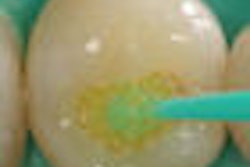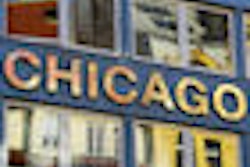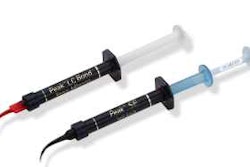
Are you using a fifth-, sixth-, or seventh-generation bonding adhesive? Who decides what generation it is? What constitutes a new generation -- the number of steps involved or something else? One company recently suggested that its all-in-one self-etch adhesive is an eighth-generation product because it is dual-cure.
To complicate matters, marketing departments are intent on convincing us that their product is like no other. The book The 22 Immutable Laws of Marketing tells us that the one of the best methods to market your product or service is to create a new category, thus separating yours from others.
For example, some salespeople will tell you that unless you replace your microhybrid with a nanohybrid, you are a dental dinosaur. But the terms are synonymous. Microhybrid composites have always contained nanofillers. Even core buildup materials have nanofillers. What may be unique is the preparation of the nanofillers.
For simplicity, let's say that the first three generations of dental adhesives were characterized by advances in monomer and resin technology, but these adhesives were bonding only to enamel via "dry" bonding. It was known that phosphoric acid etched the enamel, but it was also thought that this same acid would kill the pulp if placed on dentin.
In the late 1980s, the total-etch technique -- in which the enamel and dentin are etched simultaneously with phosphoric acid -- started to become more accepted. Prior to this, bonding to the dentin (covered with a smear layer) proved to be unsuccessful. Due to the success of these so-called fourth-generation adhesives -- such as All-Bond 2 (Bisco Dental Products) and Tenure (Den-Mat) -- they are still used today in research as a control by which all others adhesive systems are measured. Most researchers consider them the gold standard in adhesive technology.
Successful bonding requires that three distinct processes be accomplished. The fourth-generation adhesives did these using three separate bottles of different chemistries:
Etching or conditioning the dentin and enamel; this is commonly referred to as total etch, but understand that self-etch products are also total etch -- that is, they too condition the enamel and dentin simultaneously.
Primer is applied; this is a very low-viscosity resin intended to penetrate the dentin tubules. It usually contains either alcohol or acetone as a solvent. This could be compared to a wood stain -- very low in viscosity for penetration into the wood fibers.
Bonding resin is applied; this is a medium-viscosity resin with no solvent. This could be compared to paint, which is a surface treatment, not a penetrating treatment like a primer.
Next came the fifth-generation adhesives, which combined steps 2 and 3 into one bottle and incorporated a solvent that required air-drying after application. Examples of the fifth-generation products would be Single Bond (3M ESPE), which uses alcohol, and Prime & Bond NT (Dentsply International), which contains acetone as a solvent.
Which came first?
In the late 1990s, Kuraray launched Clearfil SE and self-described it as a sixth generation because it utilized a no-rinse, self-etch conditioner in lieu of phosphoric acid. However, is it substantially different than a fifth generation? Figure 1 shows that Clearfil SE regrouped the fifth-generation sequence while incorporating a fourth-generation bonding resin (no solvent).
 Figure 1: Note that Clearfil SE combines etching and priming, while the fifth generation combines the priming and bonding resin. Both require application of two separate chemistries.
Figure 1: Note that Clearfil SE combines etching and priming, while the fifth generation combines the priming and bonding resin. Both require application of two separate chemistries.The self-etch adhesives were labeled as a new generation because they dissolve the smear layer and do not require rinsing. However, if that is true, then sixth-generation adhesives were on the market before the fourth- or fifth-generation products. In the early 1990s, several self-etch products were available, such as Clearfil Liner Bond.
The late 1990s and early 2000s saw the market flooded with self-etch products that claimed less technique sensitivity for the operator and less post-op sensitivity to the patient. However, the chemical stability of combining an organic acid with a primer soon became evident. The organic acids in self-etch products are not as low in pH as phosphoric acid (an inorganic acid), were not as effective on cut enamel, and did not etch uncut enamel at all, thus limiting their intended indications.
At this point some key opinion leaders recommended first etching only the enamel with phosphoric acid, rinsing it off, then applying the self-etch products to the preparation. This helps ensure a good bond to the enamel.
Of course the next logical step would be to combine the etchant, primer, and bonding resin into one bottle. These would become known as the all-in-one adhesives. Combining complex chemistry into one bottle proved to be difficult. Many manufacturers shortened the shelf life of the products, required refrigeration, and some mandated shaking the bottle each time before dispensing since the chemistries would separate even after brief periods of time.
Self-etch is total etch
The early generations of adhesives etched only enamel, thus total etch came about once we started etching enamel and dentin simultaneously. When the self-etch products became popular, it also became common and convenient to differentiate the traditional adhesives from the self-etch by referring to the former as total etch systems. But this, too, is inaccurate since even the self-etch products treat enamel and dentin simultaneously, hence they are total etch products requiring no rinsing step.
Thanks to a few key opinion leaders, there is a trend now to classify adhesives in a simplified manner that fits for any product on the market. Every adhesive fits one of two categories:
- Etch-and-rinse system (such as phosphoric acid) followed by one to three bottles
- Self-etch (also called no-rinse systems)
- Two bottles applied separately (such as Clearfil SE from Kuraray)
- Two bottles, mixed then applied as one solution (such as Adper Prompt L-Pop from 3M ESPE)
- All-in-one (such as Xeno IV from L.D. Caulk)
The etch-and-rinse systems include what we historically call the fourth- and fifth-generation systems. Included in the self-etch no-rinse category are several variations based on application. However, some fifth-generation adhesives are now available with a self-etch component that replaces phosphoric acid -- so is that a fifth- or sixth-generation system?
Adhesive technology continues to offer us new products such as self-adhesive cements that are not bonding agents but streamline and simplify procedures.
Phillip L. Brown, D.D.S., graduated from the University of Nebraska Medical Center College of Dentistry. He had a private family practice for 15 years with an emphasis on endodontics and aesthetic dentistry. He then pursued a career in research and development of resin-based polymer restorative materials and has worked with several dental companies in the development of new products. Dr. Brown has lectured overseas with an emphasis on education and hands-on training sessions and is an active member of the American Association for Dental Research, the International Association for Dental Research, and other societies.
Copyright © 2010 DrBicuspid.com



















